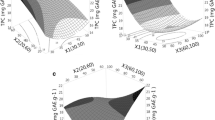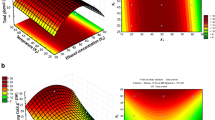Abstract
The potential of antioxidant activity of the green algae (Chaetomorpha sp.) was studied in this work. The optimum processing conditions for the extraction of antioxidant compounds from dried green algae were determined using response surface methodology (RSM). A central composite design (CCD) was applied to determine the effects of three process variables as follows: solvent concentration (percent), extraction time (min) and microwave power (w) on total phenolic contents, ferric reducing power, 2’2-dipheny-l-picrylhydrazyl (DPPH) radical scavenging activity and total antioxidant capacity assays. The independent variables were coded at five levels and CCD included 20 experimental runs with six replications at the center point. The statistical analysis of data was performed using design expert software and second-order polynomial models generated after analysis of variance (ANOVA) applied for predicting the responses. The results revealed that the highest total phenol content and reducing power were 1.09 and 0.12 mg of tannic acid equivalent/g dry weight, respectively. The maximum antioxidant activity was 0.19 mg ascorbic acid equivalent/g dry weight and DPPH was 99.8 % under MAE. The optimum conditions using RSM for the predicted responses were: microwave power 300 W, extraction time 8 min and solvent concentration 25 %, respectively. Furthermore the actual experimental values were adjacent to the corresponding predicted values which demonstrated fitness of the employed models and suitability of RSM in extraction parameters optimization.




Similar content being viewed by others
Abbreviations
- MAE:
-
as microwave assisted-extraction
- RSM:
-
as response surface methodology
- TPC:
-
as total phenol content
- FRAP:
-
as ferric reducing power
- TAC:
-
as total antioxidant capacity
References
Airanthi MKW-A, Hosokawa M, Miyashita K (2011) Comparative antioxidant activity of edible japanese brown seaweeds. J Food Sci 76(1):C104–C111. doi:10.1111/j.1750-3841.2010.01915.x
Ballard TS, Mallikarjunan P, Zhou K, O’Keefe S (2010) Microwave-assisted extraction of phenolic antioxidant compounds from peanut skins. Food Chem 120(4):1185–1192
Blanc N, Hauchard D, Audibert L, Ar Gall E (2011) Radical-scavenging capacity of phenol fractions in the brown seaweed ascophyllum nodosum: an electrochemical approach. Talanta 84(2):513–518
Bonny S, Hitti E, Boustie J, Bernard A, Tomasi S (2009) Optimization of a microwave-assisted extraction of secondary metabolites from crustose lichens with quantitative spectrophotodensitometry analysis. J Chromatogr A 1216(45):7651–7656. doi:10.1016/j.chroma.2009.09.009
Brand-Williams W, Cuvelier ME, Berset C (1995) Use of a free radical method to evaluate antioxidant activity. LWT Food Sci Technol 28(1):25–30. doi:10.1016/s0023-6438(95)80008-5
Camel V (2000) Microwave-assisted solvent extraction of environmental samples. TrAC Trends Anal Chem 19(4):229–248. doi:10.1016/S0165-9936(99)00185-5
Chew YL, Lim YY, Omar M, Khoo KS (2008) Antioxidant activity of three edible seaweeds from two areas in South East Asia. LWT Food Sci Technol 41(6):1067–1072. doi:10.1016/j.lwt.2007.06.013
Duan X-J, Zhang W-W, Li X-M, Wang B-G (2006) Evaluation of antioxidant property of extract and fractions obtained from a red alga, Polysiphonia urceolata. Food Chem 95(1):37–43. doi:10.1016/j.foodchem.2004.12.015
Fan D, Hodges DM, Zhang J, Kirby CW, Ji X, Locke SJ, Critchley AT, Prithiviraj B (2011) Commercial extract of the brown seaweed Ascophyllum nodosum enhances phenolic antioxidant content of spinach (Spinacia oleracea L) which protects Caenorhabditis elegans against oxidative and thermal stress. Food Chem 124(1):195–202
Ganesan P, Kumar CS, Bhaskar N (2008) Antioxidant properties of methanol extract and its solvent fractions obtained from selected Indian red seaweeds. Bioresour Technol 99(8):2717–2723. doi:10.1016/j.biortech.2007.07.005
Hayat K, Hussain S, Abbas S, Farooq U, Ding B, Xia S, Jia C, Zhang X, Xia W (2009) Optimized microwave-assisted extraction of phenolic acids from citrus mandarin peels and evaluation of antioxidant activity in vitro. Sep Purif Technol 70(1):63–70
Huang W, Xue A, Niu H, Jia Z, Wang J (2009) Optimised ultrasonic-assisted extraction of flavonoids from Folium eucommiae and evaluation of antioxidant activity in multi-test systems in vitro. Food Chem 114(3):1147–1154. doi:10.1016/j.foodchem.2008.10.079
Krishnaswamy, K., Orsat, V., Gariépy, Y., Thangavel, K. (2012) Optimization of Microwave-Assisted Extraction of Phenolic Antioxidants from Grape Seeds (Vitis vinifera). Food bioprocess tech :1–15
Kumar KS, Ganesan K, Rao PVS (2008) Antioxidant potential of solvent extracts of Kappaphycus alvarezii (Doty) Doty - An edible seaweed. Food Chem 107(1):289–295. doi:10.1016/j.foodchem.2007.08.016
Li Y, Qian Z-J, Ryu B, Lee S-H, Kim M-M, Kim S-K (2009) Chemical components and its antioxidant properties in vitro: An edible marine brown alga, Ecklonia cava. Bioorg Med Chem 17(5):1963–1973. doi:10.1016/j.bmc.2009.01.031
Li H, Deng Z, Wu T, Liu R, Loewen S, Tsao R (2012) Microwave-assisted extraction of phenolics with maximal antioxidant activities in tomatoes. Food Chem 130(4):928–936
Liu J-L, Yuan J-F, Zhang Z-Q (2010) Microwave-assisted extraction optimised with response surface methodology and antioxidant activity of polyphenols from hawthorn (Crataegus pinnatifida Bge.) fruit. Int J Food Sci Technol 45(11):2400–2406. doi:10.1111/j.1365-2621.2010.02416
Matanjun P, Mohamed S, Mustapha N, Muhammad K, Ming C (2008) Antioxidant activities and phenolics content of eight species of seaweeds from north Borneo. J Appl Phycol 20(4):367–373. doi:10.1007/s10811-007-9264-6
Pan Xuejun NG, Huizhou L (2003) Microwave-assisted extraction of tea polyphenols and tea caffeine from green tea leaves. Chem Eng Process 42:129/133
Pan Y, Wang K, Huang S, Wang H, Mu X, He C, Ji X, Zhang J, Huang F (2008) Antioxidant activity of microwave-assisted extract of longan (Dimocarpus Longan) peel. Food Chem 106(3):1264–1270
Patil PD, Gude VG, Mannarswamy A, Cooke P, Munson-McGee S, Nirmalakhandan N, Lammers P, Deng S (2011) Optimization of microwave-assisted transesterification of dry algal biomass using response surface methodology. Bioresour Technol 102(2):1399–1405. doi:10.1016/j.biortech.2010.09.046
Prieto P, Pineda M, Aguilar M (1999) Spectrophotometric quantitation of antioxidant capacity through the formation of a phosphomolybdenum complex: specific application to the determination of vitamin E. Anal Biochem 269(2):337–341. doi:10.1006/abio.1999.4019
Proestos C, Komaitis M (2008) Application of microwave-assisted extraction to the fast extraction of plant phenolic compounds. LWT Food Sci Technol 41(4):652–659. doi:10.1016/j.lwt.2007.04.013
Rodríguez-Bernaldo de Quirós A, Frecha-Ferreiro S, Vidal-Pérez A, López-Hernández J (2010) Antioxidant compounds in edible brown seaweeds. Eur Food Res Technol 231(3):495–498. doi:10.1007/s00217-010-1295-6
Souza BWS, Cerqueira MA, Martins JT, Quintas MAC, Ferreira ACS, Teixeira JA, Vicente AA (2011) Antioxidant potential of two red seaweeds from the Brazilian Coasts. J Agric Food Chem 59(10):5589–5594. doi:10.1021/jf200999n
Spigno G, De Faveri DM (2009) Microwave-assisted extraction of tea phenols: a phenomenological study. J Food Eng 93(2):210–217. doi:10.1016/j.jfoodeng.2009.01.006
Tabaraki R, Nateghi A (2011) Optimization of ultrasonic-assisted extraction of natural antioxidants from rice bran using response surface methodology. Ultrason Sonochem 18(6):1279–1286
Taga, M., silvia, MEEaPDE (1984) Chia Seeds as a Source of Natural Lipid Antioxidants. JAOCS ~ vol. 61, no, 5
Wang T, Jónsdóttir R, Ólafsdóttir G (2009) Total phenolic compounds, radical scavenging and metal chelation of extracts from Icelandic seaweeds. Food Chem 116(1):240–248
Zubia M, Fabre MS, Kerjean V, Lann KL, Stiger-Pouvreau V, Fauchon M, Deslandes E (2009) Antioxidant and antitumoural activities of some Phaeophyta from Brittany coasts. Food Chem 116(3):693–701. doi:10.1016/j.foodchem.2009.03.025
Author information
Authors and Affiliations
Corresponding author
Rights and permissions
About this article
Cite this article
Safari, P., Rezaei, M. & Shaviklo, A.R. The optimum conditions for the extraction of antioxidant compounds from the Persian gulf green algae (Chaetomorpha sp.) using response surface methodology. J Food Sci Technol 52, 2974–2981 (2015). https://doi.org/10.1007/s13197-014-1355-1
Revised:
Accepted:
Published:
Issue Date:
DOI: https://doi.org/10.1007/s13197-014-1355-1




